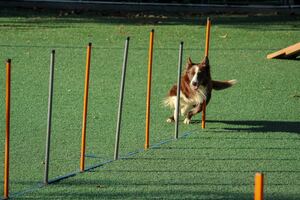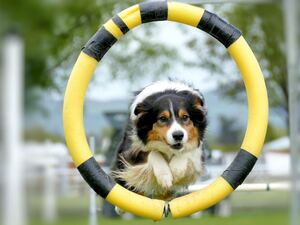
To train a dog, reward good actions with treats and love, and correct bad behavior with clear commands and discipline.
More...
Training a dog can be an enjoyable and rewarding experience for the pet owner and the canine.
However, many people need clarification on how long it takes to brain train a furry friend.
The truth is that there is no definitive answer as every dog is different, and their training needs vary depending on their breed, age, personality, and history.
This article will discuss the factors that impact dog training duration to help you prepare for the process with your pet.

How Long Does It Take To Train A Dog by Breed?
How long it takes to train a dog depends on the breed and temperament of the animal.
A dog's temperament plays an essential role in its ability to learn new skills.
With different breeds come varying degrees of intelligence and personality traits that can impact their training abilities.
Border Collies and German Shepherds, for instance, have a reputation for being quick learners due to their high level of intelligence and eagerness to please their owners.
It is common to see these breeds utilized as working animals performing various tasks or competing in events that evaluate their level of obedience.
On the other hand, Basset Hounds can be challenging to train due to their independent nature, which may result in sporadic obedience.
However, not all Basset Hounds are stubborn. With consistent training, positive reinforcement techniques, and dog games, some can learn new tricks and be obedient.
Other factors affecting a dog's learning ability include age, past experiences, health conditions, and socialization levels.
Maximizing Puppy Training Success
Puppies generally have shorter attention spans but are more receptive to new information than adult dogs, who might have already learned bad habits.
Moreover, when it comes down to training your furry friend successfully, it is necessary first to establish trust between you two.
Positive reinforcement methods are more effective in achieving this goal than harsh punishments like yelling or physical corrections. These positive methods include offering treats or verbal praise.
Understanding your dog's temperament is crucial if you want them to reach their full potential during training sessions.
With patience and attention to your dog's needs, effective instruction techniques can improve your bond and establish mutual respect.
Factors Affecting Dog Training Duration: Patience and Commitment are Key
Regarding dog training duration, the time needed to train a dog largely depends on various factors.
The training period for dogs can vary based on the individual canine's temperament, age, and breed.
For instance, the time to train a pup would differ significantly from that of an adult dog that has already developed certain habits and behaviors.
Teaching your dog new tricks takes time and effort; it requires patience and commitment from you and your furry friend.
Thus, the learning curve for canine behavior modification can be steep but generally rewards those who persevere with their pets' obedience training journey.
Age and Time Considerations in Dog Training
Puppies are known to have a shorter attention span compared to adult dogs.
However, their innate curiosity drives them to explore the world around them.
As such, puppies must receive adequate training starting at six months old.
Start puppy training early to build on the social skills learned from their mother and avoid bad habits.
By doing so, pet owners can efficiently teach their furry companions appropriate manners and behaviors that will benefit them in the long run.
On the other hand, older dogs may take longer to train since they may have already developed unfavorable habits or phobias that require patience and consistent remedying.
These undesirable behaviors can range from excessive barking, chewing on furniture or shoes, or aggression towards people and other animals.
Positive Behavior through a Conducive Learning Environment
As pet owners, we are responsible for training our pets regularly and catering to their unique learning styles and needs.
Additionally, pets need a regular routine that includes meals, playtime, and rest for optimal learning and physical health.
Training your dog early on is crucial for their lifelong behavior, leading to safer relationships with humans and other animals.
Additionally, it contributes positively towards building happier communities overall!

How Long Does It Take To Train A Dog's Personality?
Generally speaking, the time it takes to train a dog's personality depends on various factors such as breed, age, temperament, and training methods.
It is important to note that while some dogs may require basic obedience training, others have unique personalities and temperaments that demand individualized attention.
As such, it becomes necessary for owners to recognize these differences and adjust their approach accordingly.
To begin with, one must understand that every dog has distinct personality traits. These can range from being shy or aggressive to being active or lazy.
Understanding your dog's personality will help you determine what training they need and how best to approach it.
It is also vital to realize that not all dogs are the same when learning new behaviors.
Some may take longer than others, while others may learn faster but quickly forget what they've learned if not regularly reinforced.
For this reason, tailored methods are essential in helping each pup reach its full potential.
Moreover, this means considering factors such as breed tendencies, age, medical history, and even environmental circumstances before developing a personalized plan for your furry friend.
Transform a Rescued Dog into a Happy Companion
A rescued stray pup may require a patient approach to acclimate and become comfortable within its new environment.
Comparing a sheltered puppy that received proper socialization during crucial developmental stages to a rescue pup will require more attention and care.
Furthermore, these pups often need more confidence and need to adapt to unfamiliar situations with early exposure to various stimuli.
Owners of rescued dogs must work with them consistently, using positive reinforcement techniques to build trust and confidence gradually.
With patience, love, and proper training, any dog, regardless of past experiences, can grow into a happy, well-adjusted companion that enriches your life beyond measure.
Establishing Connections and Meeting Needs of Rescue Dogs
It's essential for pet owners or prospective ones seeking valuable insight into the distinct needs of rescue dogs.
Moreover, taking necessary steps such as vet visits might identify all underlying health conditions very early.
Additionally, your rescue dog has to learn how to adjust after adoption and what behaviors are acceptable in their new home.
Therefore, new pet owners should focus on bonding by playing games and walking while also paying attention to signs of distress or uncertainty.
Ultimately, building trust between animals and humans is crucial in the first few days after adoption, when adjustments are most common.
The Importance Of Consistency In Training Dogs
To efficiently train a dog new tricks, consistency is critical.
It would help if you had a well-defined and straightforward training plan that encourages your dog to learn at its pace while providing positive reinforcement.
Thus, in every session, you should accompany each command with verbal or hand signals to help your pup swiftly link actions with commands.
In addition, developing an unvarying routine will increase the likelihood of success for both you and your pet.
It's important to remember that dogs thrive on predictability; therefore, a consistent approach makes them more receptive to learning new concepts.
Unwavering Consistency: The Key to Effective Dog Training
Repeating identical gestures or phrases during each training effort can create an association between specific behaviors and their corresponding cues.
Furthermore, utilizing positive reinforcements like praise or treats helps reinforce good behavior rather than focusing solely on correcting bad behavior.
Consistency in praising desirable conduct will encourage repetition and improve obedience.
Above all, commitment is critical when teaching pets new tricks; it takes patience and perseverance, but the rewards for both owner and animal are long-lasting.

The Role Of The Trainer In Successful Dog Training
In order to succeed as a dog trainer, one must possess a variety of qualities.
Firstly, patience is vital when working with animals, especially since not all dogs respond positively on the first try.
Furthermore, a confident demeanor can also be very beneficial in training situations, helping to establish trust and respect between the trainer and their furry friend.
Moreover, it's also essential for trainers to have an understanding of animal behavior psychology.
Dog trainers must possess the trait of persistence. Some pets need several training sessions to learn new commands or behaviors.
Therefore, trainers should remain committed to the process.
Finally, by reading and interpreting dogs' body language and vocalizations, they can better tailor their training techniques based on each pet's needs.
Training Techniques
There are several effective dog training methods worth considering.
One such process involves using treats as positive reinforcement during training sessions to enhance the bond between owner and pet.
Another technique is "capturing," rewarding dogs when they display desirable behavior spontaneously.
Additionally, shaping involves gradually molding behaviors by offering rewards for small steps toward the desired outcome.
Training techniques aside, individual breed characteristics and personalities must also be considered while selecting a dog training strategy.
For example, stubborn breeds may require more patience and persistence in their training regimen than others.
Given the circumstances, dog trainers must consider a dog's age and past experiences to customize their training methods.
Healthy Habits and Stress Relief for Your Pet
High-energy breeds may need physical outlets like release walks or running to burn off excess energy before focusing on learning new commands.
Also, consistent routines aid in successful dog obedience training by setting specific times for meals and exercise.
A strong sense of structure provides stability for your furry friend's life plus reduces stress levels with predictable patterns.
Furthermore, choosing a practical approach for dog training is crucial and depends on factors like breed, age, and personality.
By taking the extra time to research these alternative approaches, individuals can achieve superior outcomes and create lifelong bonds between themselves and animals!
Effective Methods for Obedience Training in Canines
Effective methods for obedience training in canines include positive reinforcement techniques and firm yet gentle corrections when necessary.
Therefore, prioritizing humane treatment in dog training is crucial to promote good behavior without causing harm or punishment.
Note that dog behavioral strategies exceed basic commands like sit or stay and tackle breed-specific problems such as separation anxiety or aggression.
As a result, tailored approaches are necessary for different breeds of dogs to ensure effective results over extended periods.

In the Final Analysis
To sum up, training a dog requires patience and persistence while considering the differences in breed type, age, personality traits, and history.
Consistency is vital to achieving success in dog training by providing positive reinforcement for good behavior and redirecting negative actions without harsh punishment.
Dedication and time invested in finding what works best for you and your furry friend can yield astonishing results.
Likewise, it's important to remember that dog training isn't just about teaching commands but building a solid relationship between owner and pet based on trust and respect.
By understanding your dog's needs, you can create a personalized approach to help them learn new skills while strengthening their bond with you.
Similarly, investing in professional help or obedience classes can guide you in developing effective techniques for your dog's specific needs.
How long it takes to train a dog successfully relies heavily on positive reinforcement techniques, patience, and dedication from both the owner and their furry companion.
Training a dog is challenging but worth it when both parties build a strong bond based on trust and love through determination, consistency, and patience.





